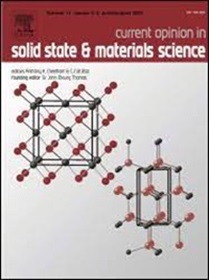From high-entropy alloys to alloys with high entropy: A new paradigm in materials science and engineering for advancing sustainable metallurgy
IF 13.4
2区 材料科学
Q1 MATERIALS SCIENCE, MULTIDISCIPLINARY
Current Opinion in Solid State & Materials Science
Pub Date : 2025-03-09
DOI:10.1016/j.cossms.2025.101221
引用次数: 0
Abstract
The development of high-entropy alloys (HEAs) has marked a paradigm shift in alloy design, moving away from traditional methods that prioritize a dominant base metal enhanced by minor elements. HEAs instead incorporate multiple alloying elements with no single dominant component, broadening the scope of alloy design. This shift has led to the creation of diverse alloys with high entropy (AHEs) families, including high-entropy steels, superalloys, and intermetallics, each highlighting the need to consider additional factors such as stacking fault energy (SFE), lattice misfit, and anti-phase boundary energy (APBE) due to their significant influence on microstructure and performance. Leveraging multiple elements in alloying opens up promising possibilities for developing new alloys from multi-component scrap and electronic waste, reducing reliance on critical metals and emphasizing the need for advanced data generation techniques. With the vast possibilities offered by these multi-component feedstocks, modelling and Artificial Intelligence based tools are essential to efficiently explore and optimize new alloys, supporting sustainable progress in metallurgy. These advancements call for a reimagined alloy design framework, emphasizing robust data acquisition, alternative design parameters, and advanced computational tools over traditional composition-focused methodologies.
从高熵合金到高熵合金:推进可持续冶金的材料科学与工程新范式
高熵合金(HEAs)的发展标志着合金设计的范式转变,摆脱了优先考虑由次要元素增强的主导贱金属的传统方法。相反,HEAs采用了多种合金元素,没有单一的主导成分,扩大了合金设计的范围。这种转变导致了高熵(ahs)家族的各种合金的产生,包括高熵钢、高温合金和金属间化合物,每种合金都强调需要考虑额外的因素,如层错能(SFE)、晶格失配和反相边界能(APBE),因为它们对微观结构和性能有重大影响。利用合金中的多种元素为从多组分废料和电子废物中开发新合金开辟了广阔的可能性,减少了对关键金属的依赖,并强调了对先进数据生成技术的需求。由于这些多组分原料提供了巨大的可能性,建模和基于人工智能的工具对于有效地探索和优化新合金至关重要,从而支持冶金的可持续发展。这些进步需要重新构想合金设计框架,强调稳健的数据采集、可替代的设计参数和先进的计算工具,而不是传统的以成分为中心的方法。
本文章由计算机程序翻译,如有差异,请以英文原文为准。
求助全文
约1分钟内获得全文
求助全文
来源期刊

Current Opinion in Solid State & Materials Science
工程技术-材料科学:综合
CiteScore
21.10
自引率
3.60%
发文量
41
审稿时长
47 days
期刊介绍:
Title: Current Opinion in Solid State & Materials Science
Journal Overview:
Aims to provide a snapshot of the latest research and advances in materials science
Publishes six issues per year, each containing reviews covering exciting and developing areas of materials science
Each issue comprises 2-3 sections of reviews commissioned by international researchers who are experts in their fields
Provides materials scientists with the opportunity to stay informed about current developments in their own and related areas of research
Promotes cross-fertilization of ideas across an increasingly interdisciplinary field
 求助内容:
求助内容: 应助结果提醒方式:
应助结果提醒方式:


